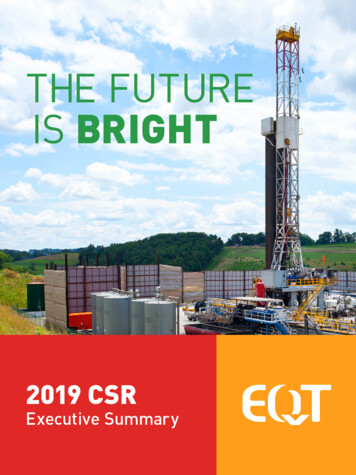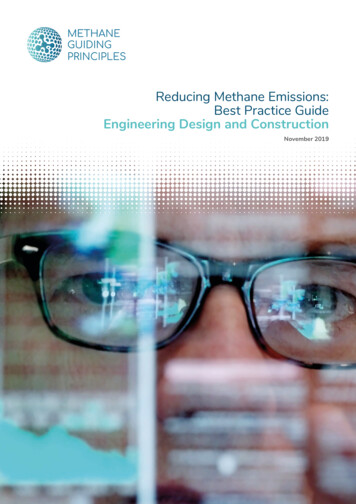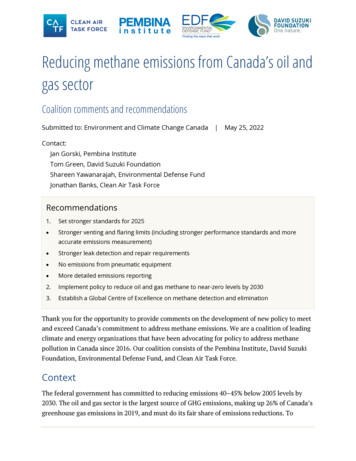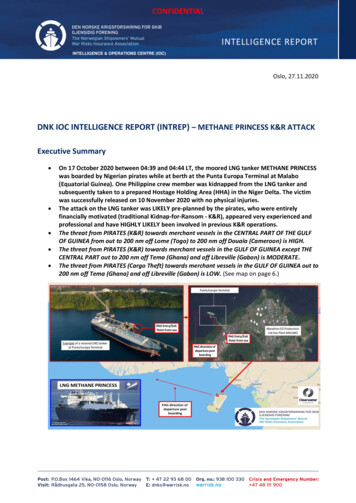
Transcription
REDUCINGENTERIC METHANEforimproving food securityand livelihoodsProject Highlights 2015-2017
REDUCINGENTERIC METHANEforimproving food securityand livelihoodsProject Highlights 2015-2017Published bythe Food and Agriculture Organization of the United NationsRome, 2019
Recommended citation:FAO & New Zealand Agricultural Greenhouse Gas Research Centre. 2019. Reducing enteric methane for improving foodsecurity and livelihoods. Project Highlights 2015–2017. Rome. 18 pp.The designations employed and the presentation of material in this information product do not implythe expression of any opinion whatsoever on the part of the Food and Agriculture Organization ofthe United Nations (FAO) or New Zealand Agricultural Greenhouse Gas Research Centre (NZAGRC)concerning the legal or development status of any country, territory, city or area or of its authorities,or concerning the delimitation of its frontiers or boundaries. The mention of specific companies orproducts of manufacturers, whether or not these have been patented, does not imply that these havebeen endorsed or recommended by FAO or NZAGRC in preference to others of a similar nature thatare not mentioned.The views expressed in this information product are those of the author(s) and do not necessarilyreflect the views or policies of FAO or NZAGRC.ISBN 978-92-5-131420-3 (FAO) FAO, 2019Some rights reserved. This work is made available under the Creative CommonsAttribution-NonCommercial-ShareAlike 3.0 IGO licence (CC BY-NC-SA 3.0 3.0/igo/legalcode/legalcode).Under the terms of this licence, this work may be copied, redistributed and adapted for non-commercial purposes, provided that the work is appropriately cited. In any use of this work, there shouldbe no suggestion that FAO endorses any specific organization, products or services. The use of theFAO logo is not permitted. If the work is adapted, then it must be licensed under the same or equivalent Creative Commons licence. If a translation of this work is created, it must include the following disclaimer along with the required citation: “This translation was not created by the Food andAgriculture Organization of the United Nations (FAO). FAO is not responsible for the content or accuracy of this translation. The original [Language] edition shall be the authoritative edition.”Disputes arising under the licence that cannot be settled amicably will be resolved by mediation andarbitration as described in Article 8 of the licence except as otherwise provided herein. The applicablemediation rules will be the mediation rules of the World Intellectual Property ules and any arbitration will be conducted in accordance withthe Arbitration Rules of the United Nations Commission on International Trade Law (UNCITRAL).Third-party materials. Users wishing to reuse material from this work that is attributed to a thirdparty, such as tables, figures or images, are responsible for determining whether permission is neededfor that reuse and for obtaining permission from the copyright holder. The risk of claims resultingfrom infringement of any third-party-owned component in the work rests solely with the user.Sales, rights and licensing. FAO information products are available on the FAO website(www.fao.org/publications) and can be purchased through publications-sales@fao.org.Requests for commercial use should be submitted via: www.fao.org/contact-us/licence-request.Queries regarding rights and licensing should be submitted to: copyright@fao.org.
PROJECT HIGHLIGHTS 2015-2017KEY ACHIEVEMENTS1Enhanced institutional capacity and knowledge sharing. Workingin 13 countries with over 150 stakeholders, the project has developed aknowledge base that increased awareness and knowledge of the potentialrole of methane in climate change and food security and can be used to supportcountries in advocating for methane mitigation. Among other things, the studieshave stimulated in-country ownership and providing two valuable outputs: (i)a successful process for establishing low carbon pathways; and (ii) a growing,useful knowledge and data set that can be used to support countries addressmethane emissions.2Increased awareness and policy advocacy. The goal of the3Catalyzed funding for methane mitigation. Collectively, the studies4Collaborative partnerships for methane mitigation. Theproject was to use the knowledge generated to enhance awareness andcommitment across governments and other stakeholders to addressmethane emissions from livestock. For example, in Uruguay this collaborativeeffort supported the country by improving the quality of its emissions inventory,better defining its reduction targets in terms of emissions intensity, and improvingthe understanding of the impacts of measures to improve productivity, andproduction efficiency.from these 13 countries identified some broad messages, generating awealth of knowledge that provides a global public good. The goal is touse this knowledge to develop low carbon pathways, to identify GHG reductioninvestments in these countries and make use of growing sources of carbonfinance. In Ethiopia, Bangladesh, Uruguay and Kenya, Phase 1 has helped tocreate an enabling environment and to catalyze additional financing for methanemitigation.partnership of the Climate and Clean Air Coalition (CCAC), the NewZealand Agricultural Greenhouse Gas Research Centre (NZAGRC), and FAOshowed that working together is a much more efficient way to achieve betterresults. The partnership has played an important role in framing and positioningthe methane mitigation discourse, by helping to transfer information andexperiences to other countries and identify collective projects or multi-countryactivities, in order to exploit synergies between countries that have similar goals,problems, and challenges.iii
MaliPROJECT HIGHLIGHTS 2015-2017SenegalBurkina Sri LankaKenyaTanzaniaArgentinaUruguayAs countries increase their ambitions towards reaching the Paris Agreement, it is essential to investigate how the livestock sector can respondto mitigate actions under different scenarios. This approach can enhanceclimate transparency, support countries to improve their own mitigationtargets and facilitate the flow of financial and technological resources for the livestock sector, enabling farmers to contribute to climate action.“Reducing enteric methane for improving food security and livelihoods” is a collaboration between the Food and Agriculture Organization of the United Nations (FAO)and the New Zealand Agricultural Greenhouse Gas Research Centre (NZAGRC). Theproject is funded by the Climate and Clean Air Coalition, FAO, and the New ZealandGovernment through its support of the Livestock Research Group (LRG) of the GlobalResearch Alliance on Agricultural Greenhouse Gases (GRA).The project aims to support low and middle income countries to identify system-specific technologies and interventions to increase livestock productivity, food securityand reduce enteric methane emissions per unit of product. The project seeks to provide guidance to decision-makers engaged in the policy discourse on mechanisms,recommendations on incentives and institutional framework necessary to incentivizeadoption of productivity-enhancing technologies and practices.Phase 1 of the project identifies emission mitigation opportunities and their associated costs and benefits, informs sector planning, and characterizes appropriate policysupport. It lays a foundation for mitigation policy action e.g. nationally appropriatemitigation actions (NAMAs) and provides a framework for measurement, reporting,and verification. The study helps attract new resources to address the incrementalcosts of low carbon growth through technology, financing, and capacity building. Italso provides an opportunity for countries in accessing climate finance through international mechanisms, such as the Green Climate Fund (GCF), but also bilateral andmultilateral funding mechanisms, as well as national financing.The project contributes to the formulation of national policy mitigation actionssuch as NAMA (Nationally Appropriated Mitigation Actions), the achievement oftargets laid out in countries’ Nationally Determined Contributions (NDCs), and theSustainable Development Goals (SDGs), in particular SDG-1 “No poverty, SDG–2“Zero Hunger”, SDG-12 “Responsible consumption and production” and SDG–13“Climate Action”.1
REDUCING ENTERIC METHANE FOR IMPROVING FOOD SECURITY AND LIVELIHOODSKEY FINDINGSMITIGATION MEASURES AND POTENTIALNumerous abatement measures are available to mitigate enteric methane emission.The measures typically fall into 4 categories: feed, animal health, genetics and addressing environmental constraints. Although the elements of good practice are likelyto be similar for all countries, production systems contexts are widely different. Interventions need to be tailored to diversity of situations. Most of these practices can improve production and provide farmers with opportunities to adapt to climate change.AVERAGERANGE OF REDUCTIONSRANGE OF PRODUCTIVITY INCREASEREDUCTION IN ENTERIC CH4EMISSION INTENSITY (%)INCREASE IN PRODUCTION (%)ARGENTINAURUGUAYBANGLADESHSRI LANKAETHIOPIAKENYATANZANIAUGANDABENINBURKINA FASOMALINIGERSENEGAL- 802-70- 60- 50- 40- 30- 20-10102030405060708090100110120130140200
PROJECT HIGHLIGHTS 2015-2017SYNERGIES BETWEEN MITIGATION AND DEVELOPMENT OBJECTIVESA non-climate incentive to address enteric methane is the private economic benefitsthat could accrue to farmers. The additional benefits and positive economic returnsthat can be generated by closely aligning emission intensity reductions with productivity gains result in lower abatement costs for producers. Analysis shows that manyactions can reduce emissions while delivering benefits in the form of improved productivity, greater income, and enhanced food and nutrition security, among others.Regions such as Latin America, sub-Saharan Africa and South Asia are likely to benefit. In Argentina and Uruguay, the large beef cattle population provides one ofthe most cost-effective opportunities to reduce enteric CH4 while meeting otherdevelopment goals. In Argentina, beef exports accounted for about 16percentand 22percent of the total value of Argentina’s exports and value of agricultural exports respectively. Uruguay exports about 70percent of its beef percent.Pursuing low-carbon development of their beef sectors Argentina and Uruguayare more likely to benefit from strategic and competitive advantages, such asincreased access to existing and emerging global markets for their low carbonbeef sandTonnes CWEbeef exports118%thousandTonnes CWEbeef exports266%correspondingcorrespondingof total beefproduction1,9generating12USD billionin exportearningsof total beefproduction1,5USD billionin exportearningsgeneratingInstituto de Promoción de la Carne Vacuna Argentina (IPVCA), 2019. Informe de exportaciones de diciembre de 2018. Available at:http://www.ipcva.com.ar/documentos/1964 1548258366 ituto Nacional de Carnes (INAC), 2018. Anuario Estadístico 2017. Available nuario-estadistico-2017 web v03.pdf3
REDUCING ENTERIC METHANE FOR IMPROVING FOOD SECURITY AND LIVELIHOODS In Sub-Saharan Africa, dairy offers sizable reduction opportunities. For example, in East Africa, between 70-80 percent of smallholders are engaged in dairyproduction and 70-98 percent of milk produced by smallholders. Livestock is oneof the main economic activities, accounting for about 26 percent of the regionalagriculture GDP.CONTRIBUTION TO GDPETHIOPIA1TANZANIA21.5% DAIRY SECTOR14% DAIRY SECTOR47GDPKENYA28% DAIRY SECTOR76GDP7443% AGRICULTURAL30% AGRICULTURAL28% AGRICULTURALGDPUGANDA23% DAIRY SECTOR4923% AGRICULTURALGDPGDP is in USD Billion124Shapiro, B.I., Gebru, G., Desta, S., Negassa, A., Nigussie, K., Aboset G. and Mechale. H. 2017. Ethiopia livestock sector analysis. ILRI Project Report.Nairobi, Kenya: International Livestock Research Institute (ILRI).Makoni, N; Mwai, R; Redda, T; Zijpp, A. van der; Lee, J. van der. 2013. White Gold; Opportunities for Dairy Sector Development Collaboration in EastAfrica. Centre for Development Innovation, Wageningen UR (University & Research centre). CDI report CDI-14-006. Wageningen.
PROJECT HIGHLIGHTS 2015-2017 In South Asia, Sri Lanka and Bangladesh are heavily reliant on milk imports; only30 and 48 percent of the national milk requirement is met through local production. Pursuing low carbon development of their dairy sectors can help reduce thedrain on the country’s foreign exchange resources, improve food and nutritionsecurity, support employment and family incomes in the rural areas.Sri LankaBangladeshMILK SELF-SUFFICIENCY314 millionlitres4.7 millionlitresnational milkproductionnational milkproductionsatisfiessatisfies30%of national demand48%of national demandSri LankaBangladeshNUTRITION & FOOD SECURITYMilk consumption gap(between national consumptionand WHO recommendation)Milk consumption in kgper capita per yearWHOrecommendation200 kgMilkCapitaYear16516436355
REDUCING ENTERIC METHANE FOR IMPROVING FOOD SECURITY AND LIVELIHOODSKEY ACHIEVEMENTS1Leverage of additional financial resources targeted towardsmethane mitigationMitigation finance is inclined towards sectors or emission sources wherequantification and monitoring of the mitigation benefits is relatively easy and wherethe economic and political risks are lower1. Catalyzing climate finance for mitigationactivities in the livestock sector requires robust GHG accounting, identification andprioritization of mitigation options, cost-benefit analyses to support decision-making.Already, the results from Phase 1 are being used to demonstrate the range of mitigationoptions and costs to countries as they develop their livestock investment programmes.As a result of the low carbon growth studies, the project has assisted countries to design investment programmes that can leverage allocations from international financialmechanisms, such as the Green Climate Fund, and multilateral development banks,such as the World Bank, to advance mitigation planning activities in the livestock sector. For example: In Kenya: Phase 1 results have been in the design of the Dairy NAMA “Low-carbon and Climate Resilient Dairy Development in Kenya” submitted to GCFfor funding. The main objective of this NAMA is to trigger low-carbon development in the dairy sector through the introduction of climate-smart livestockpractices. The NAMA aims to provide effective support to 267,000 dairy farmers,double milk output from 450 million litres to 915 million litres, increase householddairy enterprise net income by at least 50 percent and provide additional benefitsin the form of reduced labor and health burden of fuel wood collection especiallyfor women. In Ethiopia: Phase 1 results were used to inform the design of “the Livestockand Fisheries Sector Development Project” (see annex 5). Under the WorldBank supported investment project financial resources have been allocatedtowards institutional capacity building on GHG quantification and methane mitigation and towards data collection to support development of improved GHGinventory on livestock emissions. In Bangladesh: Under the World Bank supported investment project “theBangladesh Livestock Development-based Dairy Revolution and Meat ProductionProject” financial resources have been allocated towards institutional capacitybuilding on GHG quantification and methane mitigation and towards data collection to support development of improved GHG inventory on livestock emissions.6
PROJECT HIGHLIGHTS 2015-2017KenyaOPTIONS FOR LOW EMISSION DEVELOPMENT IN DAIRY SECTOR2014HERD4.8 milliondairy cowsHow to reachthe targets?2030DAIRY SECTORMILK PRODUCTION2.1 million11.5billionlactating cowslitresMILK CONSUMPTIONScenario 1BUSINESS AS USUAL110 kgABSENCE OF SPECIFIC TARGETED ACTIONSmilk / person7.5 million4.1 million3.4 billionlitres220KG22Mt CO2edairy cowsMILK PRODUCTIONMILK CONSUMPTIONlactating cowsmilk / personEMISSIONSHERDNDC EMISSIONSREDUCTIONScenario 243Mt CO2eSLOW EXPANSIONEMISSIONSADOPTION OF STRATEGIC INTERVENTION5.5 million17dairy cows12 Mt CO2eMt CO2e3.1 millionlactating cowsHERDEMISSIONS-5Mt CO2ecompared toSCENARIO 1 13%Potential contributionof DAIRY SECTOR to NDC TARGET**30% emissions reduction relative toBAU emissions of 143 MtCO2e7
REDUCING ENTERIC METHANE FOR IMPROVING FOOD SECURITY AND LIVELIHOODS2Increased awareness on role of methane mitigation and policyadvocacyThe project aimed to build the dialogue on the opportunities forreducing enteric methane emissions intensity within countries and acrosscountries, as well as at global level within the UNFCCC process. The project hasencouraged wider international and regional outreach at key events on climatechange such as:Reduction in enteric CH4 emission intensity (%) In 2017, Uruguay, participated in a high level event on Partnering to Scaleup Climate Action by Countries in the Agricultural Sectors. Uruguayserves as an example of where partnership can help build the evidencebase and mobilize countries in support of climate action. The event highlighted the benefits for Uruguay in partnering with the project.504445URUGUAY’SNDC CH4REDUCTIONTARGETS4040353029262520151050C o w - ca l fC o m p l ete c yc l e 1C o m p l ete c yc l e 2Fatte n i n g ( re a r i n gand finishing onn at u ra l g ra s s )The study found that significant reductions in emissions can be achieved throughthe combination of herd and health management, nutrition and feeding management strategies, and genetics, with an estimated reduction potential of 26-44percent in methane emission intensity and an increase in production (expressedin live-weight terms) of 40-50 percent compared to the baseline situation. Thisis in line with the Uruguay’s NDC targets for methane emission intensity reduction of 33-46 percent in 2030 through the widespread application of improvedpractices and technologies. The project has equipped countries and other stakeholders with the tools andknowledge to advocate for methane mitigation. In 2017, at the Committeeon World Food Security: is low carbon meat possible? - Options for lowcarbon meat production in a science-policy format, a representative fromEthiopia participated in high level events to advocate for methane mitigationbased on findings from the project’s work in Ethiopia. At the 22nd session of the Conference of the Parties (COP 22), Uruguayand Ethiopia led science-policy dialogue on the importance of monitoring,reporting, and verification (MRV) to identify mitigation impacts in livestockproduction systems.8
PROJECT HIGHLIGHTS 2015-20173Enhanced institutional capacity and knowledge sharingEnhancing technical capacity and knowledge sharing are key components tofacilitate the implementation and up-scaling mitigation action. Knowledgeproducts, knowledge sharing activities and partnerships include: Regional stakeholder workshops were conducted in the 13 project-participatingcountries. More than 150 stakeholders (representatives from academia, publicand private sectors, livestock sector) in the quantification of methane emissionsand assessment of mitigation options. For example, in West Africa, the projectbrought together development agencies and 20 local stakeholders to identifyintensification solutions for ruminant livestock to improve food security, whilereducing enteric methane emissions. The project has supported the generation, application, and dissemination ofknowledge in order to strengthen the capacity of countries in addressing issuesrelated to methane mitigation. This knowledge also provides a guiding frameworkfor dialogue with governments, civil society, the academic/scientific community,and the private sector to help achieve national objectives on climate policy.4Collaborative Partnerships for methane mitigationParticipation in the low carbon studies has helped forge national andinternational partnerships and cooperation to advance policy initiatives,tackle implementation challenges, and address funding constraints. It promotedknowledge exchange between countries that face similar challenges and resourceconstraints.The project has developed a network of contacts at national and regional level.Stakeholder engagement spanning multiple areas—including the public and privatesector, academia, and civil society—were central to the success of Phase 1. Intensivediscussions were held with about 150 people from government, private, academic, and NGO communities to explain, test, and adjust the studies. Country workingteams were formed to map out the study process, including identification of stateof-the-art technical information and tools, preparation of an inventory of currentknowledge on potential interventions and their costs, and setting priorities for theassessments. Across the 13 countries, study teams mostly comprised local expertssupported by technical assistance from FAO and NZAGRC. Study teams gathereddata and information, reviewed results, and worked to maintain stakeholder engagement throughout the process. This approach better equips each country to plan andimplement responses to the unique challenges.9
REDUCING ENTERIC METHANE FOR IMPROVING FOOD SECURITY AND LIVELIHOODSLESSONS LEARNEDStakeholder engagement and consensus building is essential. An important element of this work was the dialogue and consensus building that occurred, often involving multiple ministries, agencies, and stakeholders (privatesector, academia) that would not routinely engage with each other. Differentpriorities and interests were reconciled through this process, and the assessmentfindings became richer and more robust.Countries must take the leading role. Demand for low carbon development starts with the country, and countries must take a leading role if such strategies are to be effectively designed and implemented. Agreeing to the objectives, scope, and process, gaining access to accurate data, and then translatingthe findings and recommendations from the study into action all require countryleadership.Aligning project scope and objectives with national development andclimate change policies is critical. Demonstrating how methane mitigationcan support countries in achieving their goals is an important element critical tosuccess of the project.The assessments are only an initial step; support for implementationis required. As countries undertake studies to identify the mitigation potential,and improve their capacity in this area, there is likely to be an increase in demandfor policy and technical support to design and implement measures targetingmethane mitigation in the livestock sector. Consequently, follow-up support willbe required.More ambitious action is still required. Taking many of the actions outlined in the country reports, and translating them into a substantial contributionto global climate change mitigation will require increased ambition and effortto address barriers to uptake faced by farmers, bring down technology costs,support the development and transfer of new technologies and scale-up privatesector engagement and financing.10
PROJECT HIGHLIGHTS 2015-2017PHASE 2Phase 1 served as a launch-pad for this second phase focuses on: (a) implementing methane mitigation at scale in three of the countries that took part inPhase 1; and (b) supporting selected countries in replicating and extending thesuccessful Phase 1 approach.BangladeshThailandEthiopiaUgandaLatin Americaand UruguayMainstreaming enteric methane mitigation in livestock investment projectsEstablishing an enabling environment for enteric methane mitigationEstablishing an enabling environment for enteric methane mitigationIdentification of new opportunities for methane mitigation11
REDUCING ENTERIC METHANE FOR IMPROVING FOOD SECURITY AND LIVELIHOODSACTIVITIES1. Mainstreaming methane mitigation into national planningPhase 2 will work to ensure climate mitigation is integrated in three specific World Bank (WB) and/or Global Environment Facility (GEF) projects. Theseprojects plan to implement a range of measures aimed at increasing livestockefficiency and productivity. They are not climate-focused or methane-focused,yet many of the measures to be implemented in each project will also resultin methane mitigation. Influencing future investments is a key focus of Phase2. This means ensuring that enteric methane mitigation measures are ‘mainstreamed’ into livestock investment projects.Focus at country levelIn Uruguay, the Phase 2 project will collaborate with the GEF-FAO project“Climate-smart Livestock Production and Land Restoration in the Uruguayan Rangelands” to support on-farm monitoring of the impact of improvedpractices and generate improved methane emission factors to improve theirnational monitoring, reporting and verification (MRV) system in an effort toenhance mitigation ambition.Partners: Ministry of Livestock, Agriculture and Fisheries, FAO, CCAC,GEF, UruguayIn Bangladesh, the main activities of the Phase 2 project is to mainstreammethane mitigation in the Livestock and Dairy Development Project (LDDP),a 500 million dollar investment from the World Bank (WB). The project isproviding technical support to the World Bank in developing an annex projectaiming to measure and report methane emissions reduction associated withproductivity gains achieved through the LDDP. This project entitled “Article 6project” intends to bring together the livestock development objectives of theGovernment of Bangladesh and its strong commitments to address climatechange, by ensuring that LDDP mitigation outcomes can be used to: Improve the national inventory; Improve target setting in the NDC making it easier to achieve existingreduction targets, but also to raise ambition in future efforts; Engage in existing and future carbon markets within the framework ofArticle 6 of the Paris Agreement when the corresponding financial mechanisms will be in place.Partners: FAO, CCAC, the World Bank, Bangladesh Livestock ResearchInstitute, (BLRI), Department of Livestock Services, Bangladesh12
PROJECT HIGHLIGHTS 2015-2017In Ethiopia, the project will collaborate with the World Bank (‘WB’) supportedinvestment project, “the Livestock and Fisheries Sector Development Project(‘LFSDP’) to support on-farm monitoring of the impact of improved practices and generate improved methane emission factors to improve their nationalMRV system in an effort to enhance mitigation ambition.Partners: FAO, CCAC, the World Bank, Ministry of Livestock andFisheries (MOLF)2. Establishing an enabling environment for methane mitigationThe project will provide an enabling environment for enteric methane mitigation to become a mainstream activity in livestock development. The project willcreate opportunities for funding of methane mitigation through support to thedevelopment of mitigation policy actions for the livestock sector and strengthening of the institutional and individual capacity required to disseminate theimproved technologies and practices.Focus at regional and country levelIn Kenya, the project will support the State Department of Livestock (SDL)to develop and adopt higher tier livestock GHG accounting methodologiesand use these to assess the general scope for mitigation of livestock methaneemissions and to quantify the impacts of specific mitigation technologies. Theoutcomes will also have benefits to the wider East African region in providing lessons learned, training opportunities and developing regionally-relevantmethane emission factors.Partners: State Department of Livestock, Kenya, FAO, New ZealandAgricultural Greenhouse Gas Research Centre (the NZAGRC), the GlobalResearch Alliance (GRA).In Latin America and the Caribbean, the project will engage with partnerorganizations to assist countries in identifying regional priorities and needs, andsupport countries in developing action plans for streams of support related toselected themes.Partners: FAO, New Zealand Agricultural Greenhouse Gas ResearchCentre (the NZAGRC), the Global Research Alliance (GRA), TropicalAgricultural Research and Higher Education Center (CATIE).13
REDUCING ENTERIC METHANE FOR IMPROVING FOOD SECURITY AND LIVELIHOODS3. Advocacy and building opportunities for methane mitigationPhase 2 will replicate activities carried out during Phase 1, in countries/regions not previously included in the initial phase, with the aim of identifyingand assessing opportunities for methane reduction from ruminant systems.Focus at regional levelIn South-east Asia, the project will support the development of actionplans in four countries for prioritizing livestock GHG accounting and methane mitigation to support national NDC commitments.Partners: FAO, New Zealand Agricultural Greenhouse Gas ResearchCentre (the NZAGRC), the Global Research Alliance (GRA).14
ISBN 978-92-5-131420-397 8 9 2 5 13 1 4 2 0 3CA4334EN/1/06.19
and the New Zealand Agricultural Greenhouse Gas Research Centre (NZAGRC). The project is funded by the Climate and Clean Air Coalition, FAO, and the New Zealand Government through its support of the Livestock Research Group (LRG) of the Global Research Alliance on Agricultural Greenhouse Gases (GRA).










